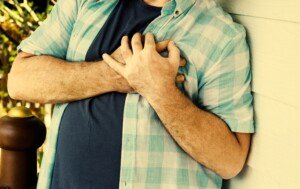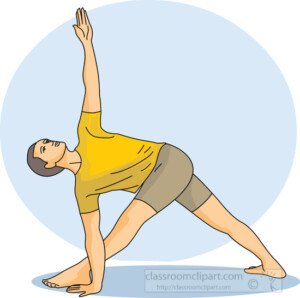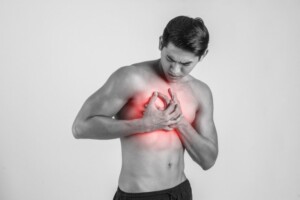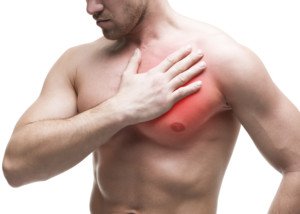A pulled chest muscle or one that’s suddenly in spasm can hurt a lot or a little – but angina, too, can come in different flavors, ranging from a muffled ache to a sudden severe pain.
Angina refers to the symptoms (usually some sort of chest discomfort) that are caused when the blood supply in the heart becomes insufficient – a demand – and the supply (oxygen) cannot keep up.
“A lack of adequate blood flow to heart muscle leads to a condition called ischemia,” says Christopher J. Hanifin, PA-C, who was previously a physician assistant in open heart surgery with Cardiothoracic Surgery of South Bend in South Bend, IN.
Ischemia is another term for inadequate oxygen, and it leads to angina.
How does angina feel like compared to a pulled, strained or spasming chest muscle?
“Most patients who experience ischemia will develop chest pain,” says Hanifin. “The pain is typically described as a squeezing or a pressure, and it’s often a very vague sensation.
“If you think about it, your body has not had much practice dealing with heart pain, so your nervous system often has some difficulty figuring out what is happening.”
A so-called cross-wiring of nerves may take place, referring pain down an arm or in the jaw.
Thus, chest pain, tightness or pressure that’s accompanied by pain or a deep ache in the arm, jaw or even back is highly suspicious for a heart problem.
Add to all that a sudden feeling of not having enough air, and this REALLY becomes concerning.
A pulled chest muscle, no matter how much it hurts or what happened, will never also lead to pain going down an arm or arising in the jaw or back.
But what about when angina causes ONLY chest pain?
There are still key differences between the chest pain of angina and that of a sore or strained chest muscle.
“Strained pectoralis muscles are usually painful when a patient flexes said muscle, and it is more localized,” says Jason Baynes, MD, a sports medicine orthopedic surgeon with Englewood Health in Englewood, NJ.
Angina, points out Dr. Baynes, may be very severe in nature, enough to make a person clutch their chest.

Shutterstock/Oleg Golovnev –
“Whereas a pectoralis strain comes and goes depending on a patient’s movements of the chest and arm.”
A muscle pull or strain will kick up when the patient moves certain ways, such as struggling to get an arm into a jacket sleeve, as this stretches the pectoralis major.
In addition, exercises, such as pushups or dumbbell routines, may also bring on the discomfort.

Dreamstime.com/ Tomasz Borucki
Overdoing exercise or other physical activity may cause muscles to experience spontaneous spasms that can come and go.
Spasms can hurt a LOT. Typically they are very brief, sometimes only seconds. Angina does not last seconds.
Key Points when Comparing Angina Chest Pain to that of an Injured Chest Muscle
• If your chest feels sore or bruised when you press your fingers to it, this would suggest a harmed pectoralis major.
• If you’re having an angina attack, you will not be able to induce more pain by pressing your fingers to the area.
• A muscle injury will feel better, or worse, with different movements. Another example is a yoga pose that stretches the chest area, aggravating a strain.

Yoga Trikonasana Pose Clipart
Whatever movements or activities trigger the pain, the pain will always be in the same spot.
• Angina attacks can cause pain in different areas, but then again, it can also be in the same area most of the time. The pain will not alter with body position or movement.
• If you have a pectoralis strain, you’ll very likely recall having “done something” within the past 48 hours to have caused it, such as lifting weights (e.g., bench press, cable crossover) or overdoing it in yoga class – which can over-stretch the pectoralis.
• Angina’s trigger is usually physical exertion, but sometimes becoming emotionally charged can also bring it on. The pain subsides when the physical activity ceases.
But keep in mind that a more dangerous form of angina, called “unstable,” can suddenly occur even during rest – even during sleep, waking the patient.
• A strained, pulled or otherwise aggravated pec muscle will not cause a squeezing or pressure feeling in the chest.
Furthermore, a strained or pulled chest muscle will noticeably start getting better within a few days of the suspected cause.
Angina will just keep on happening and happening – unless it’s treated.
One More Point to Consider
It’s possible to have BOTH angina and a pulled chest muscle!
If pain, tightness, squeezing or pressure in your chest does not go away, you should see a cardiologist.
 Christopher J. Hanifin, PA-C, is currently Department Chair and Assistant Professor, Department of Physician Assistant, Seton Hall University,
Christopher J. Hanifin, PA-C, is currently Department Chair and Assistant Professor, Department of Physician Assistant, Seton Hall University,
 In addition to being an on-field physician for many high school football teams, Dr. Baynes has been a team physician for a wide array of professional and collegiate sports teams.
In addition to being an on-field physician for many high school football teams, Dr. Baynes has been a team physician for a wide array of professional and collegiate sports teams.
 Lorra Garrick has been covering medical, fitness and cybersecurity topics for many years, having written thousands of articles for print magazines and websites, including as a ghostwriter. She’s also a former ACE-certified personal trainer.
Lorra Garrick has been covering medical, fitness and cybersecurity topics for many years, having written thousands of articles for print magazines and websites, including as a ghostwriter. She’s also a former ACE-certified personal trainer.
.














